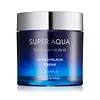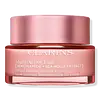What's inside
What's inside
 Key Ingredients
Key Ingredients

 Benefits
Benefits

 Concerns
Concerns

 Ingredients Side-by-side
Ingredients Side-by-side

Water
Skin ConditioningButylene Glycol
HumectantGlycerin
HumectantNiacinamide
SmoothingPhenyl Trimethicone
Skin Conditioning1,2-Hexanediol
Skin ConditioningCetyl Ethylhexanoate
EmollientPentaerythrityl Tetraethylhexanoate
EmollientPentylene Glycol
Skin ConditioningCetearyl Alcohol
EmollientButyrospermum Parkii Butter
Skin ConditioningPanthenol
Skin ConditioningRaffinose
Skin ConditioningAmmonium Acryloyldimethyltaurate/Vp Copolymer
Simmondsia Chinensis Seed Oil
EmollientDimethicone/Vinyl Dimethicone Crosspolymer
Skin ConditioningTromethamine
BufferingCarbomer
Emulsion StabilisingCetearyl Glucoside
EmulsifyingAcrylates/C10-30 Alkyl Acrylate Crosspolymer
Emulsion StabilisingXanthan Gum
EmulsifyingEthylhexylglycerin
Skin ConditioningCaprylyl Glycol
EmollientCitrus Aurantium Bergamia Fruit Oil
MaskingAdenosine
Skin ConditioningSodium Phytate
Lavandula Angustifolia Oil
MaskingCitrus Aurantium Dulcis Peel Oil
MaskingSilica
AbrasiveSodium Hyaluronate
HumectantHydrolyzed Hibiscus Esculentus Extract
Skin ConditioningLupinus Albus Seed Extract
Skin ConditioningMoringa Oleifera Seed Extract
Skin ConditioningTrehalose
HumectantGlyceryl Glucoside
HumectantPinus Sylvestris Leaf Oil
MaskingPropanediol
SolventHydrogenated Lecithin
EmulsifyingXylitylglucoside
HumectantCeramide NP
Skin ConditioningAnhydroxylitol
HumectantGlucose
HumectantSucrose Stearate
EmollientXylitol
HumectantHydroxypropyltrimonium Hyaluronate
Stearic Acid
CleansingPalmitic Acid
EmollientSucrose Palmitate
EmollientBenzyl Glycol
SolventHydrolyzed Glycosaminoglycans
HumectantCholesterol
EmollientMacadamia Ternifolia Seed Oil
EmollientOlea Europaea Fruit Oil
MaskingVitis Vinifera Seed Oil
EmollientSodium Hyaluronate Crosspolymer
HumectantHydrolyzed Hyaluronic Acid
HumectantGlyceryl Caprylate
EmollientGlycosphingolipids
EmollientSodium Acetylated Hyaluronate
HumectantActinidia Polygama Fruit Extract
Skin ConditioningHyaluronic Acid
HumectantHydrolyzed Sodium Hyaluronate
Skin ConditioningPotassium Hyaluronate
Skin ConditioningLimonene
PerfumingLinalool
PerfumingWater, Butylene Glycol, Glycerin, Niacinamide, Phenyl Trimethicone, 1,2-Hexanediol, Cetyl Ethylhexanoate, Pentaerythrityl Tetraethylhexanoate, Pentylene Glycol, Cetearyl Alcohol, Butyrospermum Parkii Butter, Panthenol, Raffinose, Ammonium Acryloyldimethyltaurate/Vp Copolymer, Simmondsia Chinensis Seed Oil, Dimethicone/Vinyl Dimethicone Crosspolymer, Tromethamine, Carbomer, Cetearyl Glucoside, Acrylates/C10-30 Alkyl Acrylate Crosspolymer, Xanthan Gum, Ethylhexylglycerin, Caprylyl Glycol, Citrus Aurantium Bergamia Fruit Oil, Adenosine, Sodium Phytate, Lavandula Angustifolia Oil, Citrus Aurantium Dulcis Peel Oil, Silica, Sodium Hyaluronate, Hydrolyzed Hibiscus Esculentus Extract, Lupinus Albus Seed Extract, Moringa Oleifera Seed Extract, Trehalose, Glyceryl Glucoside, Pinus Sylvestris Leaf Oil, Propanediol, Hydrogenated Lecithin, Xylitylglucoside, Ceramide NP, Anhydroxylitol, Glucose, Sucrose Stearate, Xylitol, Hydroxypropyltrimonium Hyaluronate, Stearic Acid, Palmitic Acid, Sucrose Palmitate, Benzyl Glycol, Hydrolyzed Glycosaminoglycans, Cholesterol, Macadamia Ternifolia Seed Oil, Olea Europaea Fruit Oil, Vitis Vinifera Seed Oil, Sodium Hyaluronate Crosspolymer, Hydrolyzed Hyaluronic Acid, Glyceryl Caprylate, Glycosphingolipids, Sodium Acetylated Hyaluronate, Actinidia Polygama Fruit Extract, Hyaluronic Acid, Hydrolyzed Sodium Hyaluronate, Potassium Hyaluronate, Limonene, Linalool
Water
Skin ConditioningCaprylic/Capric Triglyceride
MaskingBetaine
HumectantPropanediol
SolventDicaprylyl Carbonate
EmollientCetearyl Alcohol
EmollientHydrogenated Coco-Glycerides
EmollientNiacinamide
SmoothingPrunus Armeniaca Kernel Oil
MaskingGlycerin
HumectantGlyceryl Stearate
EmollientPEG-100 Stearate
Cetearyl Glucoside
EmulsifyingHydroxyethyl Acrylate/Sodium Acryloyldimethyl Taurate Copolymer
Emulsion StabilisingPropylene Glycol
HumectantDimethicone
EmollientParfum
MaskingSteareth-21
CleansingCaprylyl Glycol
EmollientCellulose
AbsorbentMica
Cosmetic ColorantCI 77891
Cosmetic ColorantEthylhexylglycerin
Skin ConditioningTocopheryl Acetate
AntioxidantDisodium EDTA
Potassium Sorbate
PreservativePolysorbate 60
EmulsifyingSorbitan Isostearate
EmulsifyingButylene Glycol
HumectantCitric Acid
BufferingEryngium Maritimum Extract
TonicMarrubium Vulgare Extract
Skin ConditioningDipsacus Sylvestris Extract
Skin ConditioningPhenethyl Alcohol
MaskingFurcellaria Lumbricalis Extract
Skin ConditioningSodium Citrate
BufferingArbutus Unedo Fruit Extract
AntioxidantTocopherol
AntioxidantLapsana Communis Flower/Leaf/Stem Extract
Skin ConditioningMaris Sal
Skin ConditioningCI 17200
Cosmetic ColorantWater, Caprylic/Capric Triglyceride, Betaine, Propanediol, Dicaprylyl Carbonate, Cetearyl Alcohol, Hydrogenated Coco-Glycerides, Niacinamide, Prunus Armeniaca Kernel Oil, Glycerin, Glyceryl Stearate, PEG-100 Stearate, Cetearyl Glucoside, Hydroxyethyl Acrylate/Sodium Acryloyldimethyl Taurate Copolymer, Propylene Glycol, Dimethicone, Parfum, Steareth-21, Caprylyl Glycol, Cellulose, Mica, CI 77891, Ethylhexylglycerin, Tocopheryl Acetate, Disodium EDTA, Potassium Sorbate, Polysorbate 60, Sorbitan Isostearate, Butylene Glycol, Citric Acid, Eryngium Maritimum Extract, Marrubium Vulgare Extract, Dipsacus Sylvestris Extract, Phenethyl Alcohol, Furcellaria Lumbricalis Extract, Sodium Citrate, Arbutus Unedo Fruit Extract, Tocopherol, Lapsana Communis Flower/Leaf/Stem Extract, Maris Sal, CI 17200
 Reviews
Reviews

Ingredients Explained
These ingredients are found in both products.
Ingredients higher up in an ingredient list are typically present in a larger amount.
Butylene Glycol (or BG) is used within cosmetic products for a few different reasons:
Overall, Butylene Glycol is a safe and well-rounded ingredient that works well with other ingredients.
Though this ingredient works well with most skin types, some people with sensitive skin may experience a reaction such as allergic rashes, closed comedones, or itchiness.
Learn more about Butylene GlycolCaprylyl Glycol is a humectant and emollient, meaning it attracts and preserves moisture.
It is a common ingredient in many products, especially those designed to hydrate skin. The primary benefits are retaining moisture, skin softening, and promoting a healthy skin barrier.
Though Caprylyl Glycol is an alcohol derived from fatty acids, it is not the kind that can dry out skin.
This ingredient is also used as a preservative to extend the life of products. It has slight antimicrobial properties.
Learn more about Caprylyl GlycolCetearyl alcohol is a mixture of two fatty alcohols: cetyl alcohol and stearyl alcohol. It is mainly used as an emulsifier. Emulsifiers help prevent the separation of oils and products. Due to its composition, it can also be used to thicken a product or help create foam.
Cetearyl alcohol is an emollient. Emollients help soothe and hydrate the skin by trapping moisture.
Studies show Cetearyl alcohol is non-toxic and non-irritating. The FDA allows products labeled "alcohol-free" to have fatty alcohols.
This ingredient is usually derived from plant oils such as palm, vegetable, or coconut oils. There is debate on whether this ingredient will cause acne.
Due to the fatty acid base, this ingredient may not be Malassezia folliculitis safe.
Learn more about Cetearyl AlcoholCetearyl Glucoside is a surfactant and emulsifier. It can be produced from synthetic of natural sources of cetearyl alcohol and glucose.
Emulsifiers help prevent ingredients from separating, such as oils and waters. It can also be used to enhance the texture of products.
As a surfactant, Cetearyl Glucoside helps during the cleansing process. By gathering all the dirt and oils, it allows these molecules to be washed away easily.
Learn more about Cetearyl GlucosideEthylhexylglycerin (we can't pronounce this either) is commonly used as a preservative and skin softener. It is derived from glyceryl.
You might see Ethylhexylglycerin often paired with other preservatives such as phenoxyethanol. Ethylhexylglycerin has been found to increase the effectiveness of these other preservatives.
Glycerin is already naturally found in your skin. It helps moisturize and protect your skin.
A study from 2016 found glycerin to be more effective as a humectant than AHAs and hyaluronic acid.
As a humectant, it helps the skin stay hydrated by pulling moisture to your skin. The low molecular weight of glycerin allows it to pull moisture into the deeper layers of your skin.
Hydrated skin improves your skin barrier; Your skin barrier helps protect against irritants and bacteria.
Glycerin has also been found to have antimicrobial and antiviral properties. Due to these properties, glycerin is often used in wound and burn treatments.
In cosmetics, glycerin is usually derived from plants such as soybean or palm. However, it can also be sourced from animals, such as tallow or animal fat.
This ingredient is organic, colorless, odorless, and non-toxic.
Glycerin is the name for this ingredient in American English. British English uses Glycerol/Glycerine.
Learn more about GlycerinNiacinamide is a multitasking form of vitamin B3 that strengthens the skin barrier, reduces pores and dark spots, regulates oil, and improves signs of aging.
And the best part? It's gentle and well-tolerated by most skin types, including sensitive and reactive skin.
You might have heard of "niacin flush", or the reddening of skin that causes itchiness. Niacinamide has not been found to cause this.
In very rare cases, some individuals may not be able to tolerate niacinamide at all or experience an allergic reaction to it.
If you are experiencing flaking, irritation, and dryness with this ingredient, be sure to double check all your products as this ingredient can be found in all categories of skincare.
When incorporating niacinamide into your routine, look out for concentration amounts. Typically, 5% niacinamide provides benefits such as fading dark spots. However, if you have sensitive skin, it is better to begin with a smaller concentration.
When you apply niacinamide to your skin, your body converts it into nicotinamide adenine dinucleotide (NAD). NAD is an essential coenzyme that is already found in your cells as "fuel" and powers countless biological processes.
In your skin, NAD helps repair cell damage, produce new healthy cells, support collagen production, strengthen the skin barrier, and fight environmental stressors (like UV and pollution).
Our natural NAD levels start to decline with age, leading to slower skin repair, visible aging, and a weaker skin barrier. By providing your skin niacinamide, you're recharging your skin's NAD levels. This leads to stronger, healthier, and younger looking skin.
Another name for vitamin B3 is nicotinamide. This vitamin is water-soluble and our bodies don't store it. We obtain Vitamin B3 from either food or skincare. Meat, fish, wheat, yeast, and leafy greens contain vitamin B3.
The type of niacinamide used in skincare is synthetically created.
Learn more about NiacinamidePropanediol is an all-star ingredient. It softens, hydrates, and smooths the skin.
It’s often used to:
Propanediol is not likely to cause sensitivity and considered safe to use. It is derived from corn or petroleum with a clear color and no scent.
Learn more about PropanediolWater. It's the most common cosmetic ingredient of all. You'll usually see it at the top of ingredient lists, meaning that it makes up the largest part of the product.
So why is it so popular? Water most often acts as a solvent - this means that it helps dissolve other ingredients into the formulation.
You'll also recognize water as that liquid we all need to stay alive. If you see this, drink a glass of water. Stay hydrated!
Learn more about Water